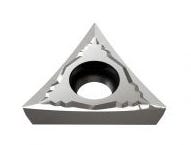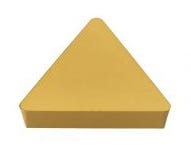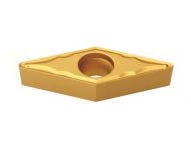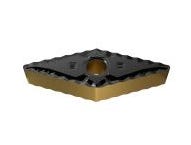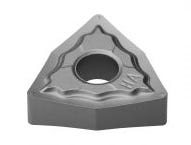Carbide Turning Inserts
The UK's largest range of turning inserts.


Browse By Shape
Browse By Brand
Milling Cutters
What is a milling cutter?
A milling cutter is a tool that can be used in a CNC or manual milling machine and a CNC lathe with live tooling capabilities. When milling, the tool will rotate and the job will move with the milling bed; moving in a horizontal or lateral movement but not vertically. The main spindle moves vertically, which is where the tool is held in a fixed position, and uses the milling cutters flutes (cutting edges) to cut the material. Different tooling geometries will help define where and when each individual tool is best suited.
What is an End Mill?
An End Mill is a style of milling cutter which can perform multiple applications including profiling, plunging, counter boring, slotting, contouring and shouldering. End mills cut in a rotational direction on a transversal plane moving horizontal, lateral and vertical. This makes them versatile and allows them to perform so many different applications. End mills range from 2-6 flutes but we don’t class 2 flutes as an end mill but instead a slot drill.
What is a Slot Drill?
A Slot Drill is a milling cutter that has 2 flutes. A 2-flute geometry allows for greater chip evacuation which is best suited for cutting slots without flute clogging. Slot drills will have 1 flute that is to the centre (centre-cutting), allowing the slot drill to plunge (cut down). It may be beneficial to open a slot with a slot drill then use a 3-4 flute end mill to make the process faster. However, only having 2 flutes can prevent higher feed rates from being achieved compared with higher fluted end mills.
What is the differences between a Slot Drill and an End Mill?
A slot drill is a mixture of a drill and an end mill meaning it can plunge in like a drill then slot across like an end mill. Conversely, an end mill will primarily cut laterally and horizontally. Slot drills will have a flute that comes to the middle and an End Mill will have clearance in the centre. A slot drill has one flute that is slightly longer than the other which allows the tool to plunge.
How does the number of flutes affect a cutter?
The number of flutes can affect the specifications and the applications a cutter can be used for. For example, non-ferrous materials often require a 2 flute cuter to help with swarf evacuation. However, when cutting harder materials like Stainless Steel it may be more suitable to use a 3 or 4 flute tool for increased strength. The higher the number of flutes, the shallower each flute will be, thus creating a stronger core (centre of the tool).
What is the difference between General Performance and High-Performance cutters?
General performance tooling can be found in ranges of HSS, Powder Metal and Solid Carbide cutters. These ranges perform well on low to medium hardness steels, Stainless Steels and Cast Iron.
High Performance cutters (HPC) are designed for much higher metal removal rates (sometimes ultra-high). HPC tooling is supplied in a wide variety of different geometries to aid high chip removal rates.
These include a variable helix which breaks the harmonics of the tool; in turn helping to prevent vibration and increasing tool life. Unequal spaced flutes will help improve surface finish as it acts as a wiping edge and can drastically improve surface finish requirements. A double core, found in our Titanox Power range for Exotic and Stainless Steel machining, strengthens your tool when pushing metal removal rates to their limit.
What is the difference between HSS, Powder Metal and Solid Carbide?
HSS – High Speed Steel is best for manual or semi-automatic machining with unstable setups. Due to the toughness and durability of HSS, it does not chip easily and isn’t affected by vibration like Carbide is. Also, the cost of HSS is usually far more economical than Powder Metal and Carbide in general machining applications.
Powder Metal – Powder Metal is the bridge between HSS and Carbide. It is perfect for use on manual or CNC machines where there are vibrations or certain constraint like an unstable setup. The atomic structure of powder metal means that it is durable and tough like HSS (helping minimize the effect of vibrations) but has the wear resistance and tool life of carbide.
Carbide – Carbide substrates can be found in different ‘grains’ which indicate performance levels, which include micrograin, ultrafine micrograin and nanograin (the finest and highest performance type of carbide). These will all affect the performance as the smaller the grain the tighter the atomic structure which, in turn, increases performance. To see the full benefits of carbide, a solid setup (virtually no vibrations and the capacity for high speed and feed rates) with a hydraulic holder or precision collet chuck is required. This will prevent run out that in turn increases tool life.
Why would I choose a replaceable head milling cutter?
The initial costs of buying a shank and head can seem expensive but, in the long run, is an efficient method to save money. This is because after the initial investment, you will only subsequently need to purchase a new head, which provides long-term cost savings as opposed to purchasing a new cutter each time. This method will also save potential downtime as the shank is already in the holder, so you won’t be needing to reset the tool every time the edge goes as it has a very high repeatability.
When would I use a milling cutter with a corner radius or chamfer prep?
A corner radius or chamfer prep edge geometry helps to strengthen a tool’s edge, which is highly recommended when machining difficult materials. By using edge preparation, you could prevent the tool from chipping as could easily happen when using a standard sharp edge. It will create a more stable cutting edge as it has more consistency if the edge isn’t breaking off. It can greatly reduce cycle times as you’re able to push the tools harder knowing there is less chance of chipping or fracturing.
We supply a wide range of turning inserts from leading manufacturers Korloy and YG-1. Popular turning inserts include CNMG, DNMG, TNMG, WNMG, CCMT, CCGT, DCMT, DCGT, VBMT, VBGT and much more. Our range includes dedicated coated grades for ferrous metals and uncoated grades for aluminium and other non-ferrous materials. Our carbide turning inserts are manufactured with dedicated chipbreakers for medium cutting or finishing or roughing applications in either continuous or intermittent cutting.
Contact us on 01924 869610 to help you select the best turning insert for your application!
Don't have an account?
Creating an account has many benefits: check out faster, keep more than one address, track orders and more.
Or
Checkout as a Guest
Place your order without creating an account for extra convenience.









